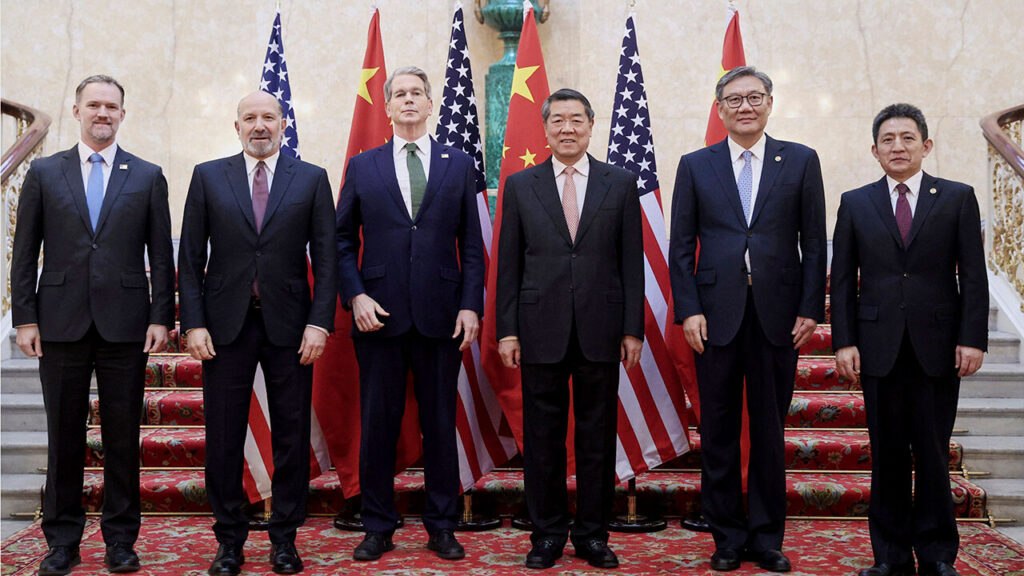On June 9th, high-ranking officials from the United States and China convened for yet another significant round of trade negotiations at Lancaster House. This historic neoclassical mansion, situated in picturesque surroundings near Buckingham Palace, has a storied past. Commissioned in the year 1825 by the “Grand Old” Duke of York, the venue is bound to evoke a sense of history and grandeur. Notably, this Duke also gained fame through his military maneuvers, which have been immortalized in a well-known children’s song, and thus the luxurious setting serves as an ironically fitting backdrop for pivotal discussions of economic strife that have escalated into what many refer to as a trade war.
As the delegates arrived at Lancaster House, it was clear that the stakes were high. The ongoing trade tensions between the two superpowers have reverberated throughout global markets, affecting economies far beyond their immediate borders. This delicate yet contentious trade relationship is underpinned by tariffs, negotiations over intellectual property, and the critical issues surrounding technology and cybersecurity. Both nations have at times engaged in aggressive posturing, resulting in substantial tariffs imposed on goods, which in turn have drawn complaints from various sectors, including agriculture and manufacturing, that depend on accessible global markets.
During the talks, American officials, led by Trade Representative Katherine Tai, sought to emphasize the need for structural reforms to address unfair trade practices they claim have been perpetuated by China. They expressed concerns about the theft of intellectual property and the unfair advantages that certain Chinese firms appear to enjoy, particularly in high-tech industries. On the opposing side, China’s Vice Premier Liu He articulated a counter-narrative, emphasizing mutual cooperation and the importance of working towards a balanced trade relationship. Liu underscored that both countries would need to consider the global repercussions of their negotiations, especially as businesses worldwide are feeling the pressure from increased tariffs and supply chain disruptions.
Footing the bill of these trade talks is not merely isolated to government representatives; the implications of these meetings extend deeply into the private sector. Executives from major companies—ranging from technology giants like Apple to agricultural leaders such as Archer Daniels Midland—are keen observers of the proceedings. With emerging voices demanding clearer pathways to stabilize their markets and reduce uncertainty, the pressure mounts on government officials to reach a consensus rather than falling into the proverbial rabbit hole of endless back-and-forth negotiations.
Geopolitical considerations also play a significant role in these discussions. The interplay between U.S.-China relations and broader global dynamics cannot be overlooked. For instance, while these nations grapple with their bilateral issues, external factors such as relations with the European Union, the economic rise of India, and the geopolitical maneuvers of Russia factor into the strategy of both Washington and Beijing. Thus, as talks unfold within the sophisticated halls of Lancaster House, the subject matter and potential resolutions implicate varied international alliances and economic agreements.
As the sessions progressed, the tone oscillated between optimistic overtures and gravitas concerning unresolved tensions. Each side offered proposals that appeared mildly conciliatory but proved to be laden with specifics still to be addressed through rigorous negotiations. The overall environment indicated a recognition that while progress was necessary, achieving substantial results would require concessions that both sides might find increasingly hard to navigate.
In conclusion, these recent meetings at Lancaster House represent a critical juncture in U.S.-China trade negotiations—a space where the weight of history meets the urgency of modern economic challenges. The outcomes of these discussions not only affect the bilateral relationship between the two prominent powers but also have broader implications for the global economic landscape. As both parties emerged from their respective discussions, the world watched closely, hopeful yet wary of the potential paths forward that could lead to either a resolution or further escalation.



